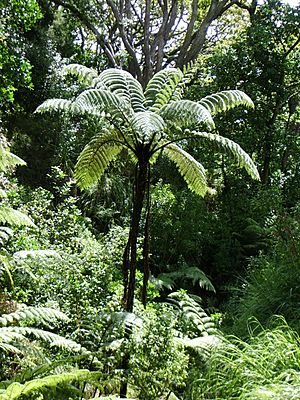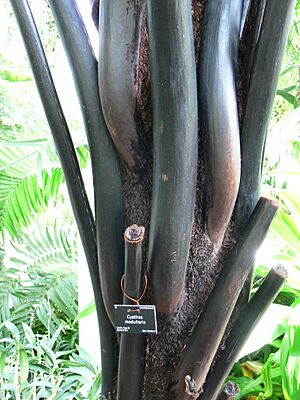Black tree fern facts for kids
Quick facts for kids Black tree fern |
|
|---|---|
 |
|
| Scientific classification | |
| Synonyms | |
|
The Black Tree Fern, also called mamaku, is a very tall fern. Its scientific name is Sphaeropteris medullaris. It is also known by another scientific name, Cyathea medullaris. This amazing plant can grow up to 20 meters (about 65 feet) high! You can find it in the southwest Pacific Ocean, from Fiji all the way to Pitcairn Island. In the Māori language, it has other names like katātā, kōrau, or pītau.
Contents
Where the Black Tree Fern Grows
The Black Tree Fern, or Sphaeropteris medullaris, is often found in the lowland forests of New Zealand's North Island. In the South Island, it grows in specific areas. It likes wetter places near the coast. However, it is rare in drier eastern parts and not found in Canterbury or Otago.
In New Zealand, you can also see it on the Three Kings Islands in the far north. It grows on Stewart Island/Rakiura in the far south and in the Chatham Islands too. Beyond New Zealand, this fern lives in Fiji, the Marquesas Islands, Tahiti, the Austral Islands, and Pitcairn Island. It does not grow in the Kermadec Islands.
What the Black Tree Fern Looks Like

The trunk of the Black Tree Fern is black. It has special hexagonal (six-sided) marks from where old fronds (fern leaves) used to be. These marks make the trunk look very unique.
The fronds can be as long as 5 meters (about 16 feet). They curve upwards from the top of the plant, which is called the crown. Older, dead fronds usually fall off, except on very young plants. The main parts of the fronds are called pinnae. They are about 40 centimeters to 1 meter long. The underside of these pinnae has small scales with spines along their edges.
The stems that hold the fronds, called stipes, are thick and black. They feel very rough. These stipes are also covered in black scales with spines. You can easily tell S. medullaris apart from other similar ferns. Just look for the hexagonal scars on its trunk and the spiny scales on its frond stems.
How People Use the Black Tree Fern
The trunks of tree ferns, including the Black Tree Fern, have been used in simple ways. People have used them as basic building materials. They also make temporary paths or walkways with them.
An old book from 1889, called The Useful Native Plants of Australia, says that Indigenous Australians ate the soft inside part of this fern's trunk. This part, called the pith, contains starch, which is a type of energy food. It was similar to sago, a food made from palm trees.
Growing Black Tree Ferns
You can grow Sphaeropteris medullaris from fresh spores, which are like tiny seeds. However, this takes a long time. It is easier to move young plants from one place to another. You can also plant freshly cut trunks. These trunks will usually grow new fronds if you water them carefully. Once they are established, these ferns are strong and can grow well in different conditions.
See also
 In Spanish: Árbol helecho negro para niños
In Spanish: Árbol helecho negro para niños



